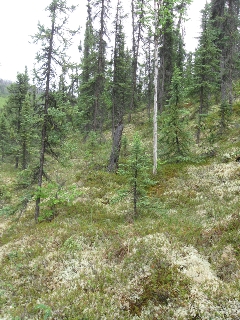AUTHORS
Tamara K. Harms1,3, Samuel T. Norlin2, Jeremy B. Jones1
1 - Institute of Arctic Biology, University of Alaska, Fairbanks AK
2 - Geophysical Institute, University of Alaska, Fairbanks AK
3 - Corresponding author: Tamara K. Harms (tharms@ualaska.edu)
THE ECOLOGICAL QUESTION
What influences flux of nitrogen from catchments underlain by discontinuous permafrost?
ECOLOGICAL CONTENT
Catchment biogeochemistry, boreal forest, discontinuous permafrost, nitrogen (N)
WHAT STUDENTS DO
Students work with a large dataset describing nitrogen dynamics in the Caribou-Poker Creeks Research Watersheds, small watersheds in the boreal forest that are underlain with various extents of permafrost cover. Students use spreadsheet and graphics software to investigate responses of N cycling to permafrost, seasonal patterns, and inter-annual variation by 1) making observations concerning long (inter-annual) and short-term (seasonal) patterns in nutrient concentrations in streams, 2) hypothesizing about physical and biological conditions influencing nitrogen chemistry, and 3) testing predictions using graphical analyses. The first activity provides a guided approach to addressing a research question with the available data. Supplemental activities are inquiry-based and instructors can either specify analyses to perform or choose to allow students to gain experience with exploratory data analysis in more advanced courses.
SKILLS
Drawing observations from graphical data, hypothesizing, calculations and preparation of figures from large datasets, graphical analyses, facilitated group learning, written presentation of results
STUDENT-ACTIVE APPROACHES
Skills developed include investigating causal relationships, calculations, preparation of graphs, and interpretation of data. Communication activities include think-pair-share, class discussion, and presentation of findings with the class or in written reports.
ASSESSABLE OUTCOMES
Formative assessment via small-group and class discussion; display-quality figures; written and verbal presentation of observations, analyses, and interpretation
SOURCES
Bonanza Creek Long-Term Ecological Research Program (http://www.lter.uaf.edu/)
DOWNLOADS
- Full Article Text [doc], [pdf]
- Student dataset (3 Microsoft Excel worksheets, organized by activity. The first, labeled “Activity 1” contains NO3- and DON concentrations (µmol/L), mean daily stream discharge (L/s), and DON and NO3- flux (g N ha-1 d-1) for 3 headwater catchments at CPCRW in 2007. The catchments contrast in their permafrost extent and catchment size. The second worksheet labeled “Activity 2” contains data from Activity 1 alongside precipitation data (cm). The third worksheet labeled “Activity 3” contains precipitation, discharge, and NO3- and DON concentrations for each catchment for 2002-2007.) [xls]
- Faculty dataset (contains the student data, amended with example graphs and calculations.) [xls]
Data sets
ACKNOWLEDGMENTS
We thank contributors to the Bonanza Creek LTER program for assistance with data collection.
CITATION
Tamara K. Harms, Samuel T. Norlin, and Jeremy B. Jones. June 2011, posting date. Nitrogen biogeochemistry of headwater catchments underlain by discontinuous permafrost. Teaching Issues and Experiments in Ecology, Vol. 7: Practice #5 [online]. http://tiee.esa.org/vol/v7/issues/data_sets/harms/abstract.html
